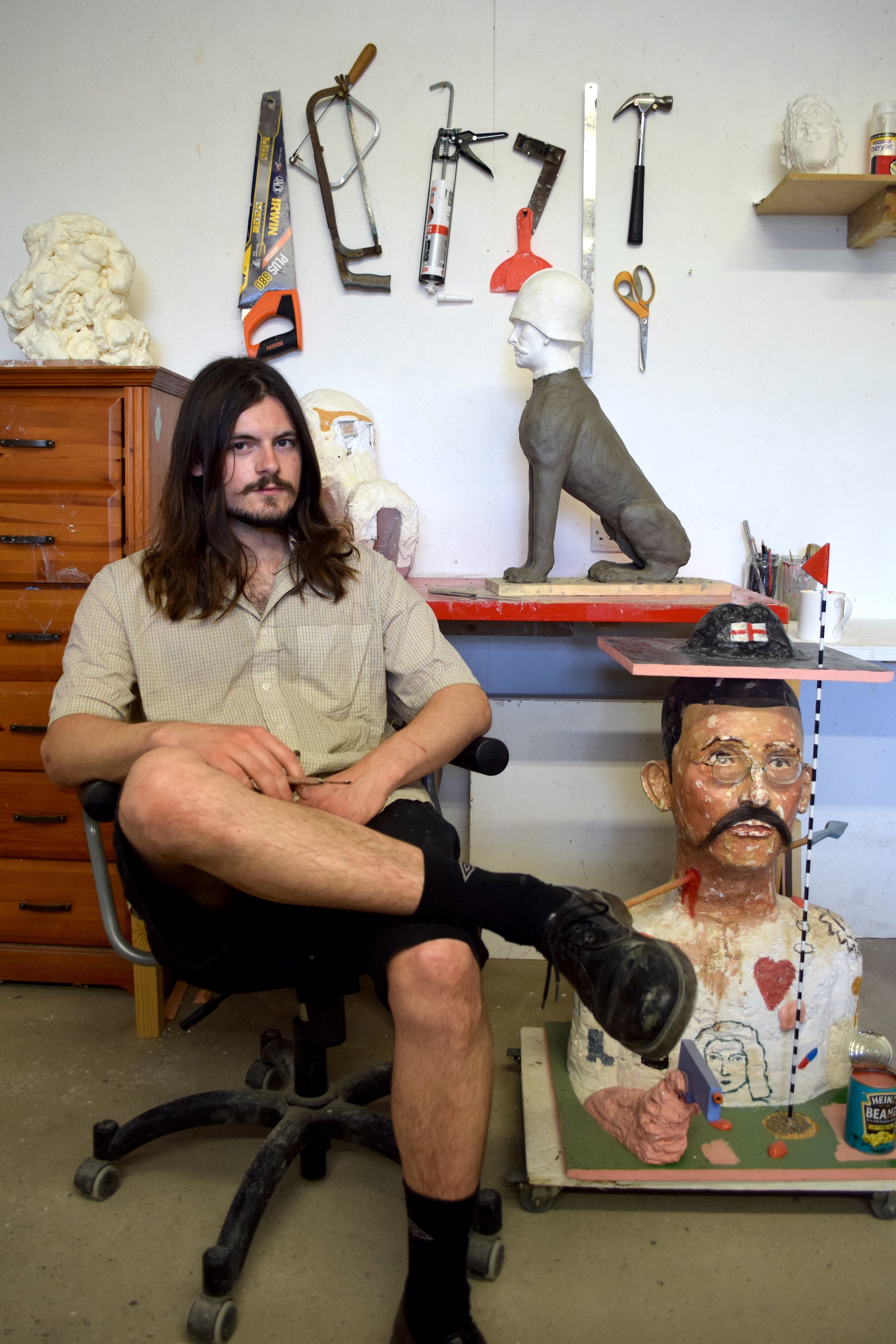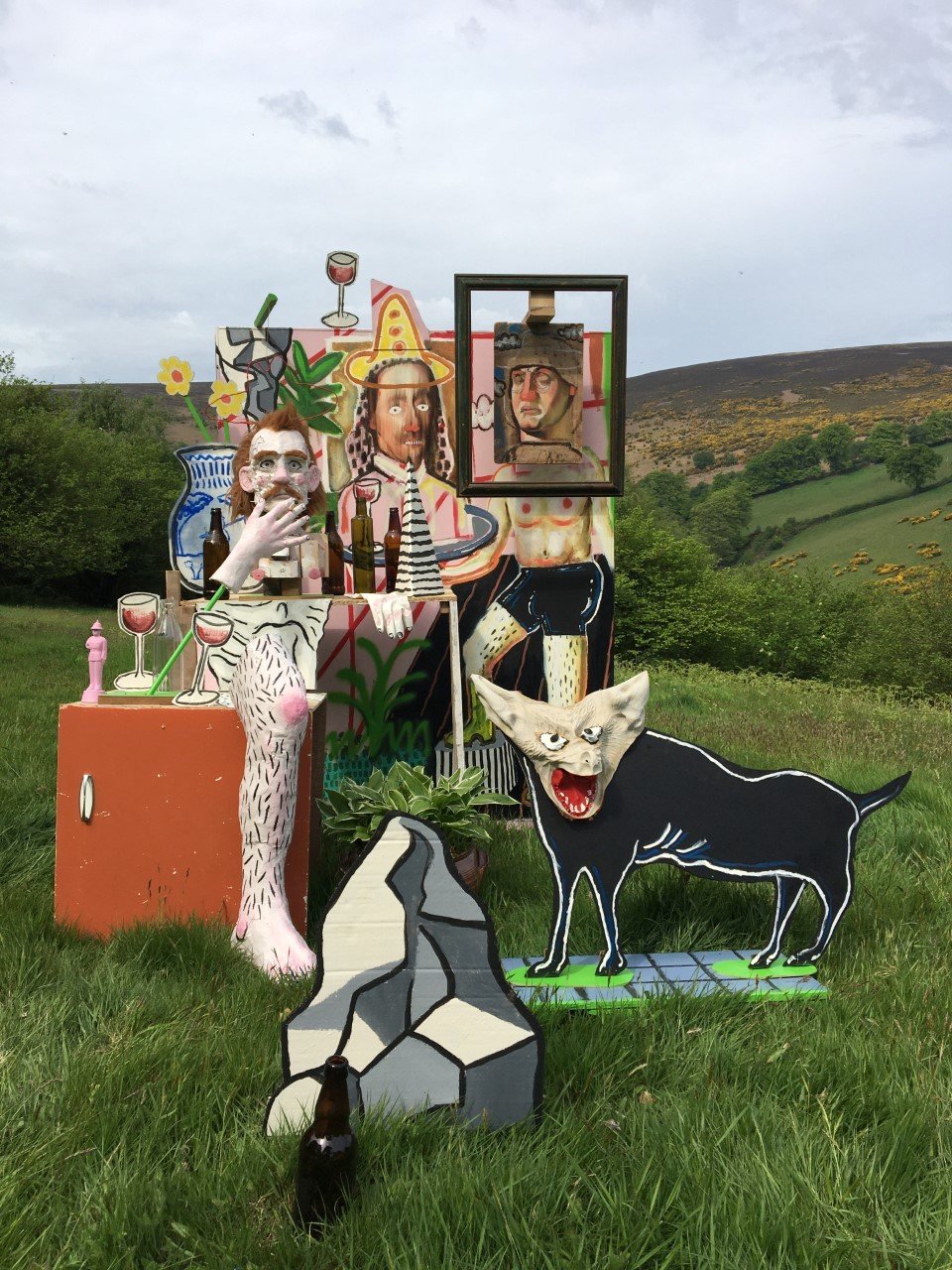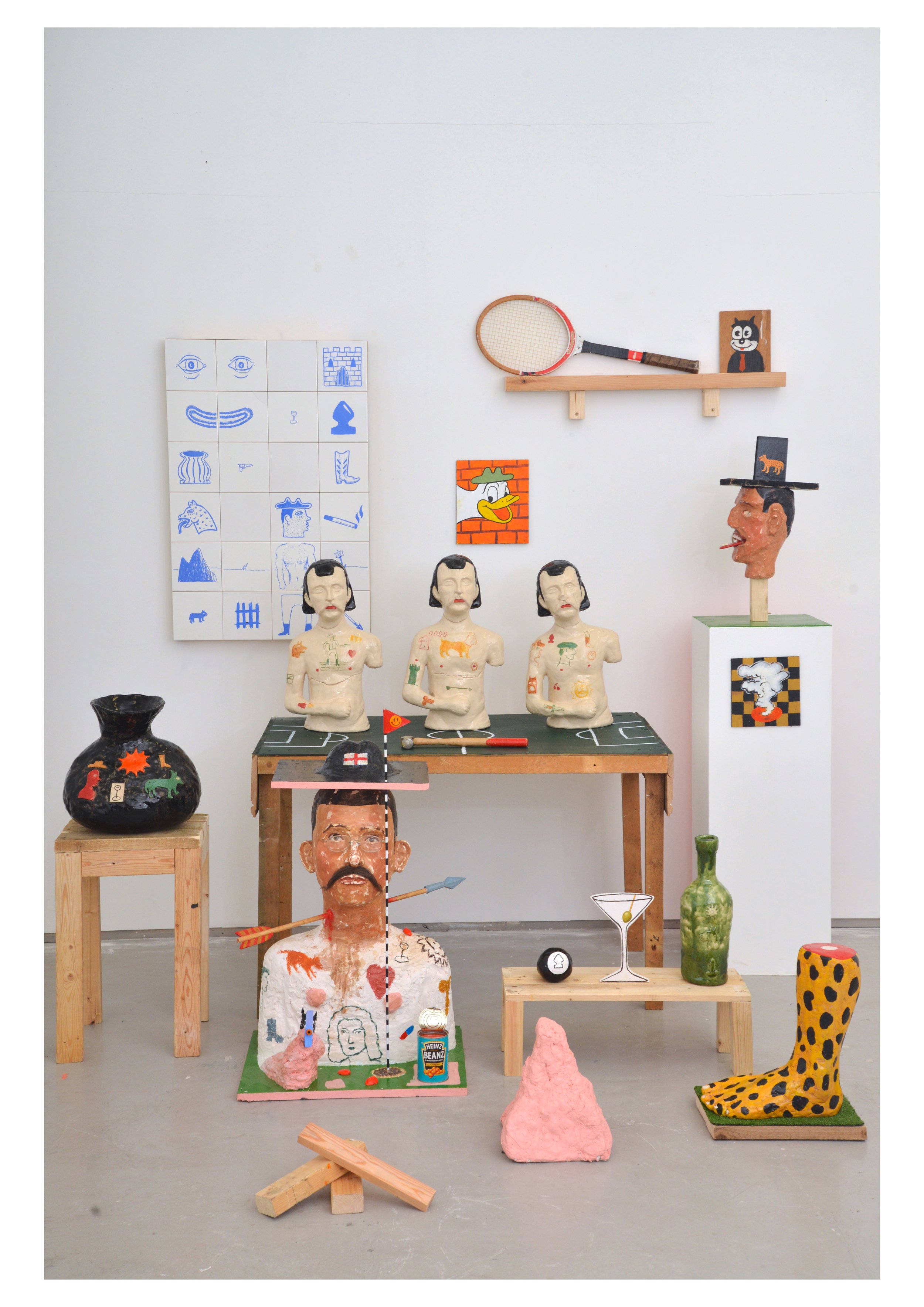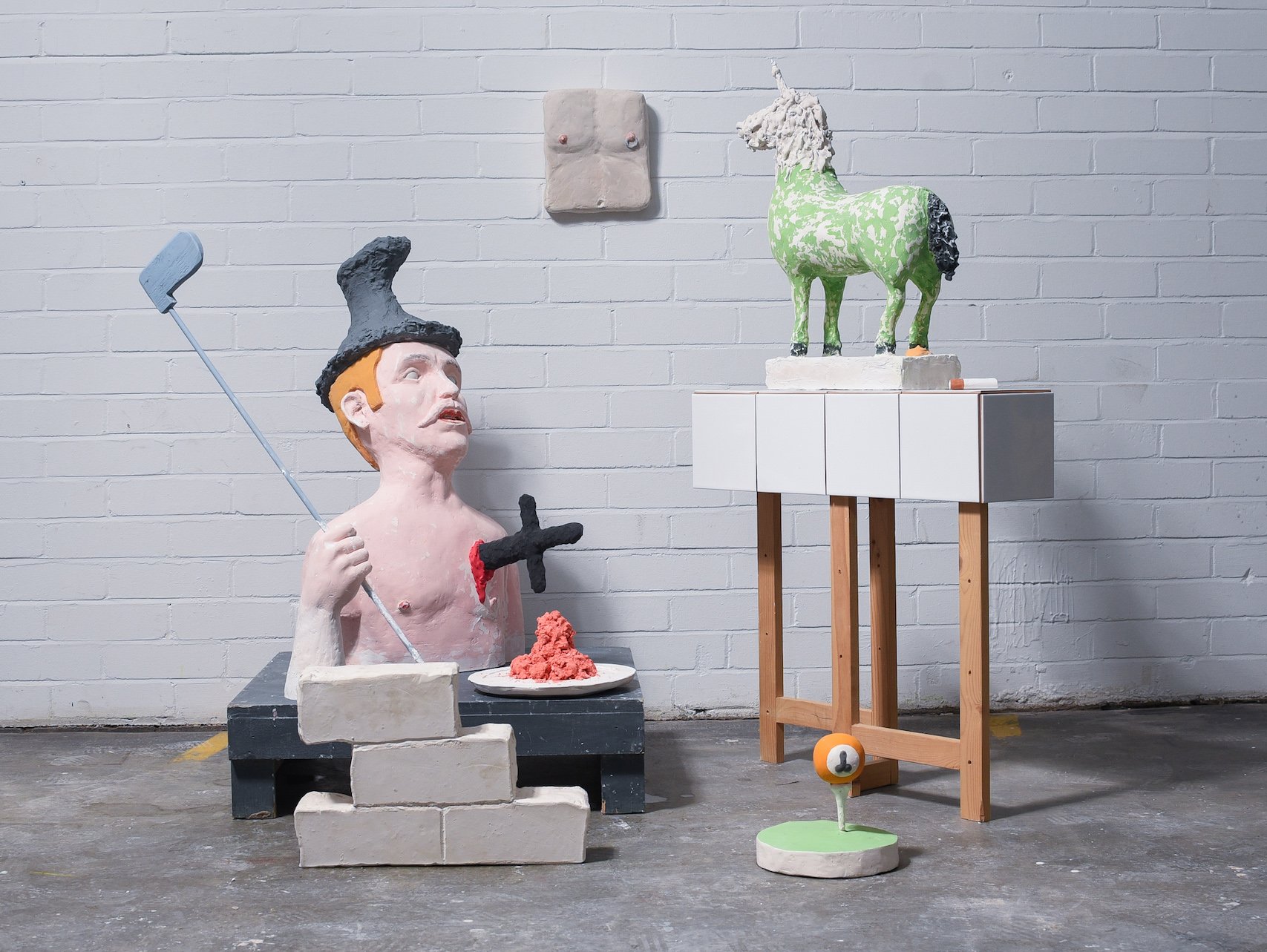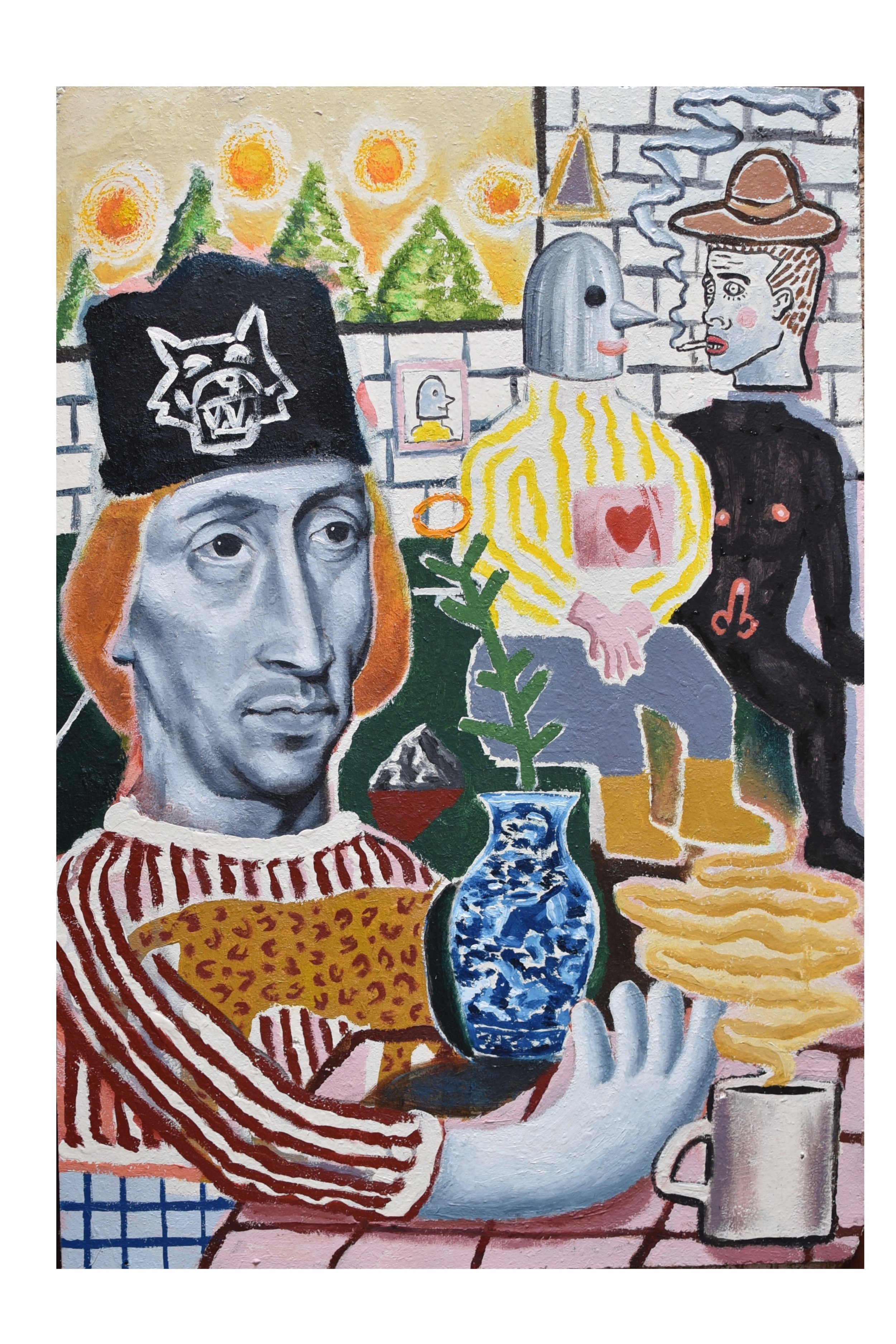ARTIST INTERVIEW: Alexander Wilmoth
Please introduce yourself. What inspired you to pursue a career in art?
I’m Alex Wilmoth, a mixed media artist based in Bristol. I focus mostly on painting and sculpture which often combine to form larger scale installations.
I was always drawing from a very young age, often creating characters and forming worlds around them, so I suppose this isn’t too different from the work I create now. I began painting at school and realised the infinite possibility of image making it provided, I painted for a long time until I came to university in Bristol, where I began expanding the worlds I created into three dimensions. Since then I’ve been experimenting with any material and process I can get my hands on, accumulating knowledge that will eventually allow me to create anything I can imagine.
Your various series of mixed media works often feature an array of objects which come together in an installation. Where do you find your inspiration? What is the significance of the objects in your work?
I am often inspired by historical artefacts and the narratives that they have accumulated over their existence and how these can warp and completely change through time. So I see the objects within my installations as artefacts that are accumulations of my experiences and a range of interpretations from historical sources. When the objects are shown together, they create a joint narrative, the symbols covering their surfaces start to relate and connect in different ways, sometimes repeating over multiple works. I’m trying to create a distinct iconography that will allow the viewer to link the works and decipher a narrative for themselves. This links to my interest in the way we attach narratives to objects, forming theories around their existence and leading us to manufacture myths that become ingrained into our wider cultural fabric.
Thinking about ‘A Gentleman’s Club’, how did you come up with the concept? What was your process from start to finish?
It started with a crude drawing depicting a general arrangement of objects, the drawing didn’t outline exactly what the objects were. I spent a lot of time accumulating references from history, pop culture and mundane elements of day to day life. I like the idea of mixing things that perhaps contradict each other, in doing so I’m able to create absurd narratives and try to make humour out of things that shouldn’t be humorous, trying to reflect on the idiosyncrasies we are often faced with. It’s quite an intuitive process when I’m making, the narrative organically grows as I build more of the world around the characters that inhabit it. Often the meaning and ideas behind the work are not obvious at first, but the more I progress through a project, the clearer they become and the more I am able to play around with them. These realisations inspire future works pushing narratives and ideas forward and expanding them into new unknown territory.
The painting ’Tinker’, was featured as part of the RBA Rising Stars. What is the story behind this piece?
Although this piece is a painting, the process follows a very similar pattern to when I am creating my 3D works. If you look at my paintings and installations, you can see there is a clear link in the visual language used. As with ‘A Gentleman’s Club’, a narrative often forms around a character; in this piece it started with the tin man in the background. Ideas start to accumulate as I search for references, there is often a lot of trial and error. I like to keep a lot of mistakes visible, they become part of the finished work itself. I like the idea that they are memories or ghosts within the work. I also like the idea of using a reference’s history and narrative, to then form a new one when combined with other references that perhaps shouldn’t belong together - it’s interesting to see how they react with one another.
How does your work reflect you as an individual?
In my pieces there are elements of seriousness that are completely offset by absurdness; I think this reflects my character. I also feel like the huge amount of symbols and details within my work reflect my difficulty in understanding the complexity of the world, but still trying to connect the dots. Most people will relate to this, especially in today's society where we are bombarded with media and information constantly, so I think I partly make my art to try and better understand myself and the environment around me.
What thoughts and feelings would you like to evoke from the viewer? How do you feel when creating your work?
I like the viewer to be confused but then try to take comfort in not knowing the answer, instead finding a narrative themselves. I always enjoy hearing how a viewer might interpret my work and connect things within it that I had never thought of, or that might be completely different from what the last person had said. I especially enjoy children’s reactions to my work, as they are very inquisitive and often seem to spot things that adults don’t. I like the idea that a viewer might get a bit lost in the work and provide them with some escapism. This is definitely what it provides me when I’m creating a piece, it’s certainly a meditative experience.
Which project has been your favourite to work on?
‘A Gentleman’s Club’ was a great experience, it was the last piece I made as part of my university degree and I went all out on it. It felt really good to be so stuck into a project and making something on a much larger scale than usual. I was also combining so many making techniques that were completely new to me, so I learnt a lot through making that installation. Other than this, I am currently working on a group exhibition with my partner which will open in December. It’s very exciting to be collaborating with someone you’re so close to, to be ambitious and try to create something on a large scale that slightly stresses you out, I think the payoff will be big though.
Are there any artists in particular who you admire? Do they have an influence on your own work?
David Altmejd, Jamie Fitzpatrick, Francis Upritchard and Jason Baldock to name a few, are all amazing figurative sculptors that have inspired me the past few years. There is so much detail in their work, lots of different elements come together to form deep narratives. All of them also have this playful element to their work that is definitely something I like to bring across myself. The range of materials they use has been inspiring, I’ve tried experimenting with similar materials, which has definitely taught me a lot and has pushed me closer to finding more effective ways of making.
What has been your biggest achievement so far as an artist? Has there been any challenges?
As part of showing my art in Wells Contemporary last Summer, I won the chance to go on a residency in the South of France; I’ll be going in October for three weeks. This will be the first residency I’ve been on, so it’s a very exciting prospect, I'm interested to see how a change of environment will affect the art I make. I haven’t had a solid three weeks to purely create since university, so I’m very excited by that. In terms of challenges, I think navigating the art world and trying to get my name out there is the biggest one. I am still fairly fresh out of university, so I still have a lot of learning to do, but I am very determined.
Why do you think art is important in society?
I think it’s important in the way that it pushes ideas forward, inspiring the next generation to take what’s been done and shape it into a narrative that fits their time. It’s a progression of ideas and views that are continually shaped by their context. It’s the sharing of ideas between times. You can tell a lot about a time period by looking at their art, the issues and customs that were common among many other things. Art also has the ability to allow people to connect, to relate to each other in an abstract way. It allows you to evoke a feeling that you can’t quite put your finger on that perhaps other creative outlets aren’t able to touch on.


